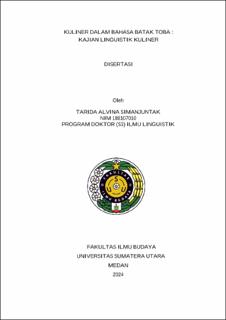| dc.description.abstract | This study analyzes the language and culinary concepts within the Batak Toba community from a linguistic perspective. It examines culinary-related terms, expressions, and meanings in the Batak Toba language to understand the relationship between language and the patterns of word formation in Batak Toba culinary naming. The research focuses on three key issues: (1) the word formation of culinary terms in the Batak Toba language, (2) the naming of culinary items in Batak Toba, and (3) the semantic description of culinary terms in Batak Toba A qualitative approach with an ethnographic method was employed in this study. The research was conducted in regions where Batak Toba is predominantly spoken, particularly around Lake Toba. Four regencies were selected as research sites- Toba Regency North Tapanuli Regency, Humbang Hasundutan Regency, and Samosir Regency due to their predominantly Batak Toba-speaking communities. The data in the study consisted of oral and written sources Oral data included culinary name preparation processes in Batak Toba culture, and words or phrases related to culinary practices in the Batak Toba language. Written data were obtained through the researcher's observations of printed documents, such as books and other written records in Batak Toba. All data were analyzed using domain analysis, taxonomic analysis, and componential analysis. The findings reveal that word formation in Batak Toba culinary naming involves several key mechanisms, including affixation, compounding, and reduplication. The naming patterns involve affixation processes, such as the prefixes ni- mar-si- the infix- in-, the suffixi, and the confixes ni-an, -in-+-an. Additionally, eleven culinary naming processes in Batak Toba were identified, namely: naming based on place of origin, part reference, shape resemblance, main ingredients, color, cooking or processing methods, primary seasoning, taste, onomatopoeia, serving method, and consumption style. Regarding semantic criteria, several lexical categories were found, including foods that are mixed and consumed raw, such as naniura, tuak, itak, and tape. Cooked foods were categorized based on three primary cooking media: fire-based (pinanggang, tinutung, saong), water-based (robus, kukus, sornop), and oil-based (goreng, tumis). Paraphrase constructions of MSA and molecular structures were used to describe the meanings of culinary nouns based on their functional categories, material composition, processing methods, consumption styles, and post-cooking appearances. | en_US |


